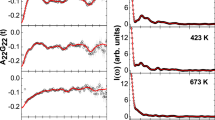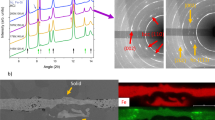Abstract
IT was first shown by W. L. Fink and E. D. Campbell (Trans. Am. Soc. Steel Treat., 9, 717; 1926), and independently by N. Seljakow, J. Kurdumoff, and N. Goodtzow (NATURE, 119, 494; 1927), that quenched carbon steels contain a phase with a tetragonal crystal structure, which might be considered as a deformation of the body-centred cubic structure of α-iron. This has been confirmed by other investigators, and our present knowledge of the tetragonal martensite may be briefly summarised as follows. The axial ratio increases from about 1.03 at 0.8 per cent carbon to 1.06 at 1.4 per cent carbon. At lower contents of carbon the interference doublets corresponding to the tetragonal lattice are not resolved, but in photograms of very rapidly cooled specimens the α-Fe-lines are slightly displaced in such a way as to indicate a tetragonal deformation. The higher the carbon content and the higher the axial ratio, the larger is also the volume of the unit cell.
This is a preview of subscription content, access via your institution
Access options
Subscribe to this journal
Receive 51 print issues and online access
$199.00 per year
only $3.90 per issue
Buy this article
- Purchase on Springer Link
- Instant access to full article PDF
Prices may be subject to local taxes which are calculated during checkout
Similar content being viewed by others
Author information
Authors and Affiliations
Rights and permissions
About this article
Cite this article
ÖHMAN, E. Crystal Structure of Martensite. Nature 127, 270–272 (1931). https://doi.org/10.1038/127270b0
Issue Date:
DOI: https://doi.org/10.1038/127270b0
Comments
By submitting a comment you agree to abide by our Terms and Community Guidelines. If you find something abusive or that does not comply with our terms or guidelines please flag it as inappropriate.



